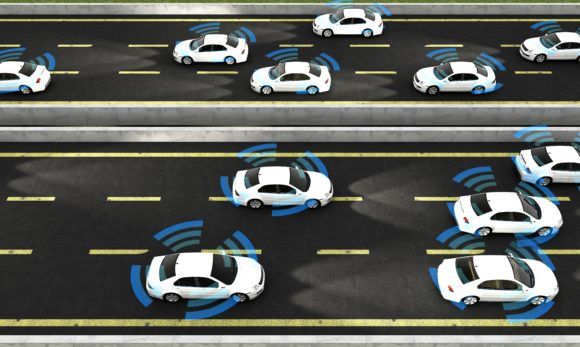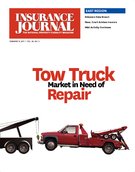Technology companies and traditional auto manufacturers are racing to deploy fully automated cars without driver controls within the next three or so years. Their immediate goal is to develop fully autonomous vehicles that provide taxi-like services within limited urban and suburban geographic footprints, and only under benign operating conditions. Their longer-term goal is to develop vehicles that can travel to most locations in most driving conditions.
The adoption of autonomous vehicles is intrinsically related to the roads on which those smart vehicles will travel.
Freeways and Smart Infrastructure
Freeways are relatively friendly environments for autonomous vehicles. The freeway-driving environment is comparatively simple, and although speeds are high, sensors and computer chips do not face the same reaction time limitations as human drivers. Fully autonomous vehicles will be able to travel with much tighter spacing between vehicles than is prudent — or lawful — for conventional cars. This creates the prospect of increasing road capacity without the need to build new highways or expand existing freeways.
Redesigning existing highways to accommodate autonomous cars and trucks traveling at high speed in platoon formations with conventional cars is likely to require more than just dedicated lanes. Getting a platooning vehicle out of a close pack of speeding cars and integrated with the flow of conventional cars will pose significant challenges. Solving the platooning problem may require “smart road” technology under which vehicles interact with the imbedded infrastructure.
There will be accidents involving autonomous vehicles in platoon formation and conventional cars. There will be insurance claims relating to smart road infrastructure, including product liability and cyber risk issues.
Rural Roads and Other Less Traveled Ways
Autonomous vehicles rely on a range of sensors, such as lidar, radar and visual light cameras, and on detailed maps that are continually updated based on the cumulative data on road construction and other temporary changes in the driving environment collected by all of the vehicles in the fleet. The initial deployment of autonomous taxi fleets will likely to be limited to relatively small geographic areas where a dense level of near real-time mapping can be achieved. Moving beyond well-mapped areas will require autonomous vehicles that can function largely on sensors, without data on recent road conditions.
When Technology Fails
In the fall 2016, the National Highway and Safety Administration issued a Federal Automated Vehicle Policy that requires automated vehicles to have the capacity to “fall back” to a minimum risk condition. The fall back minimum risk condition will depend on the circumstances. A fully autonomous vehicle might pull over and wait for a rain squall to pass, or refuse to travel on roads where “visibility” as measured by its sensors is impaired. Travelers could be stranded for lengthy periods in cars without driver controls, generating insurance claims.
“Fall back” solutions for vehicles traveling with tight spacing at high speed are needed before autonomous trucks or cars can operate in platooning formations on freeways.
Fully autonomous vehicles that retain driver controls are likely to use the same technological approach to fall back to a minimum risk condition as autonomous cars: Pulling to the side of the road and shutting down. The difference will be the option for the (hopefully sober) driver to continue in human-controlled mode.
In contrast, cars that are not fully autonomous but have sophisticated driver assist systems will be able to operate without human input for extensive periods, but may rely on a human to provide the fall back response. The potential for auto insurance and product liability claims where a human is involved in a fall back to minimum risk condition scenario will be greater than for fall back situations involving fully autonomous vehicles.
Topics Auto Autonomous Vehicles
Was this article valuable?
Here are more articles you may enjoy.



 German Insurtech Wefox to Replace CEO After Board Rejects Mubadala Sales Plan
German Insurtech Wefox to Replace CEO After Board Rejects Mubadala Sales Plan  Cyber Insurance Market ‘Stable’ With Potential for Growth, Says AM Best
Cyber Insurance Market ‘Stable’ With Potential for Growth, Says AM Best  Farmers Adjusters Cry Foul Over Workloads, Claims Handling in Letter to Regulators
Farmers Adjusters Cry Foul Over Workloads, Claims Handling in Letter to Regulators  Allstate, Nationwide Post Dramatic Q12024 Homeowners Loss Ratio Drops: S&P
Allstate, Nationwide Post Dramatic Q12024 Homeowners Loss Ratio Drops: S&P 



